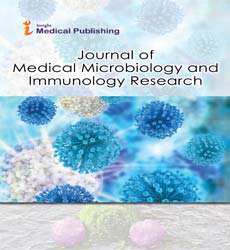Role of Memory T-Cells in Tumors and Chronic Infections
Department of Natural Sciences, School of Arts and Sciences, Lebanese American University, Lebanon
- Corresponding Author:
- Xianghua Yan
Department of Natural Sciences
School of Arts and Sciences
Lebanese American University, Lebanon
E-mail: xianghua.yan@lau.edu.lb
Received Date: November 02, 2021; Accepted Date: November 17, 2021; Published Date: November 24, 2021
Citation: Yan X (2021) Role of Memory T-Cells in Tumors and Chronic Infections. J Med Microbiol Immunol Res Vol.4 No.2:20
Copyright: © 2021 Yan X. This is an open-access article distributed under the terms of the Creative Commons Attribution License, which permits unrestricted use, distribution, and reproduction in any medium, provided the original author and source are credited.
Introduction
T cell immunological memory is a vital element of the adaptive immune system. The basic principle is that pathogen exposure causes the development of long-lived memory T cells, which offer a rapid and stronger immune response upon re-encounter with the same pathogen, ensuring efficient protection after pathogen reinfection or vaccination. While pathogenic elimination and thus re-establishment of quiescence was initially assumed to be required for the formation of immunological memory, new advances in the area have demonstrated that memorylike T cells can be detected among exhausted T cell responses in ongoing infections or malignancies. As a result, these cells, which can be identified by the expression of the transcription factor T-Cell Factor 1 (TCF1) or the chemokine receptor CXCR5, retain proliferative potential and the ability to self-renew while also replenishing the pool of antigen-specific exhausted effector T cells, thereby mediating viral or tumor control [1]. TCF1+ memory-like or precursor T cells can, surprisingly, exhibit T cell exhaustion features, as seen in many actively-persisted viral infections, including Human Immunodeficiency Virus (HIV) and Hepatitis B or C viruses in humans, Lymphocytic Choriomeningitis Virus (LCMV) infections in mice, and tumor settings in both humans and mice. Most notably, TCF1+ T cells are responsible for the immunological boost that occurs after immune checkpoint blockage in immunotherapy. Increasing our understanding of the molecular properties of these memory-like or progenitor T cells will thus drive the design and development of innovative immunotherapies to modify depleted T cell responses in chronic infections and malignancies. An enhanced cell sorting approach for isolating TCF1+ precursor T cells from solid tumors was discovered and created. The researchers used transcriptome analysis of PD1+ T cells derived from murine B16 tumors as well as primary human melanoma tumors to discover an enriched expression of Slamf6 due to lack of Entpd1 (encodes CD39) and Havcr2 (encodes TIM3) expression among precursor T cells [2].
Based on these expression patterns, it was demonstrated that PD1+Slamf6+CD39-TIM3- Tumor-Infiltrating Lymphocytes (TILs) had greater proliferative potential when isolated, transplanted, and challenged than PD1+Slamf6+CD39+TIM3+ TILs. As a result, it effectively proved a realistic method for improving the isolation of superior TILs, which can significantly increase the efficacy of adoptive cell treatment. The inhibitory receptor CD160's role in CD8 T cell responses to persistent viral infection. It was originally discovered that CD160 expression correlates with improved clinical indicators such as increased CD4 T cell counts and lower viral burden in HIV patients. Furthermore, it uses the preclinical chronic LCMV paradigm to effectively illustrate that CD160 is essential for long term viral control. Importantly, it was discovered that the lack of viral control is caused by a reduction in the formation of TCF1+ precursor T cells in the absence of CD160, and hence a reduction in the ability to sustain a longterm T cell response. Thus, CD160 signalling is required for the production of TCF1+ precursor T cells in response to chronic viral infection. A mouse model was used in an experiment to evaluate T cell responses to persistent antigen delivered by hepatocytes. It was discovered that fatigued intrahepatic precursor T cells retain proliferative and self-renewal ability, similar to splenic precursor T cells responding to prolonged viral infections [3]. For the first time, it is shown that progenitor T cells have higher metabolic and mitochondrial capacity than their CXCR5- counterparts. This is a significant finding that tackles a critical issue about how T cell fatigue and T cell metabolism are regulated and linked. This article emphasizes the crucial function of memory-like or precursor T cells in a number of diseases, emphasizing the significance of furthering our understanding of memory T cell biology in order to build new immunotherapies or improve the efficacy of existing ones.
References
- Utzschneider DT, Charmoy M, Chennupati V, Pousse L, Ferreira DP, et al. (2016) T cell factor 1-expressing memory-like CD8(+) T cells sustain the immune response to chronic viral infections. Immunity 45: 415–427.
- Im SJ, Hashimoto M, Gerner MY, Lee J, Kissick HT, et al. (2016) Defining CD8+ T cells that provide the proliferative burst after PD-1 therapy. Nature 537:417–421.
- Leong YA, Chen Y, Ong HS, Wu D, Man K, et al. (2016) CXCR5(+) follicular cytotoxic T cells control viral infection in B cell follicles. Nat Immunol 17:1187–1196.
Open Access Journals
- Aquaculture & Veterinary Science
- Chemistry & Chemical Sciences
- Clinical Sciences
- Engineering
- General Science
- Genetics & Molecular Biology
- Health Care & Nursing
- Immunology & Microbiology
- Materials Science
- Mathematics & Physics
- Medical Sciences
- Neurology & Psychiatry
- Oncology & Cancer Science
- Pharmaceutical Sciences
